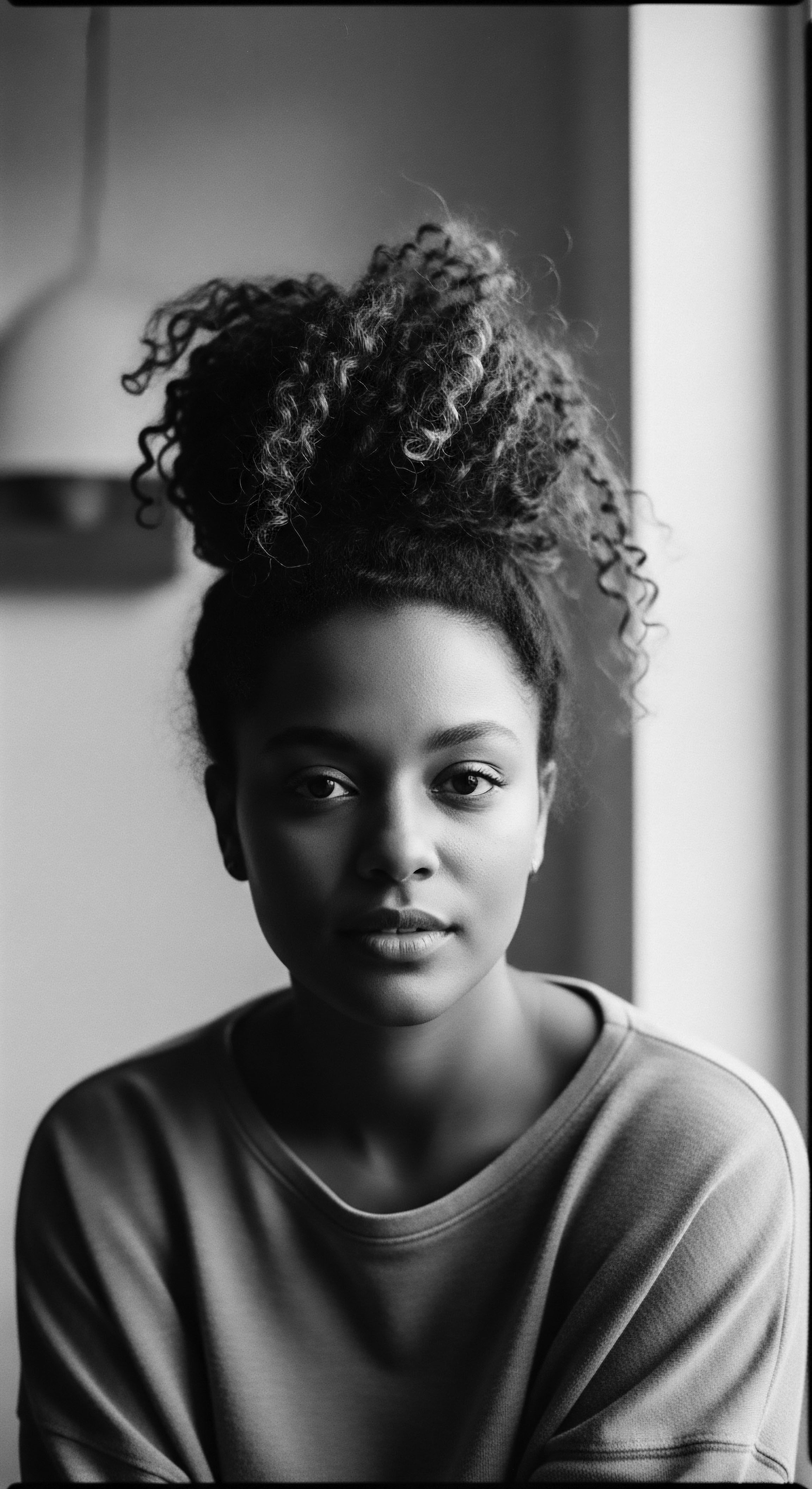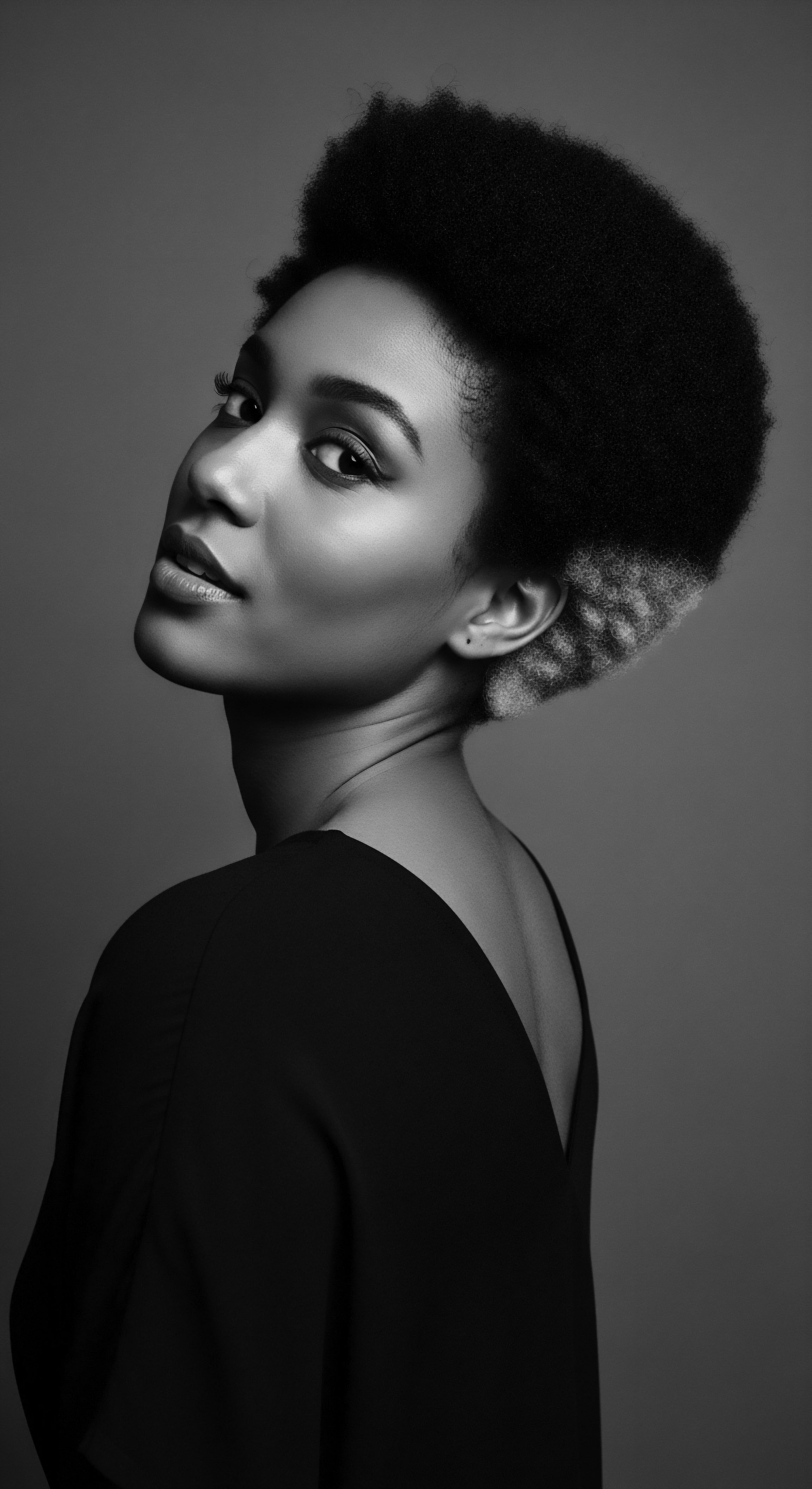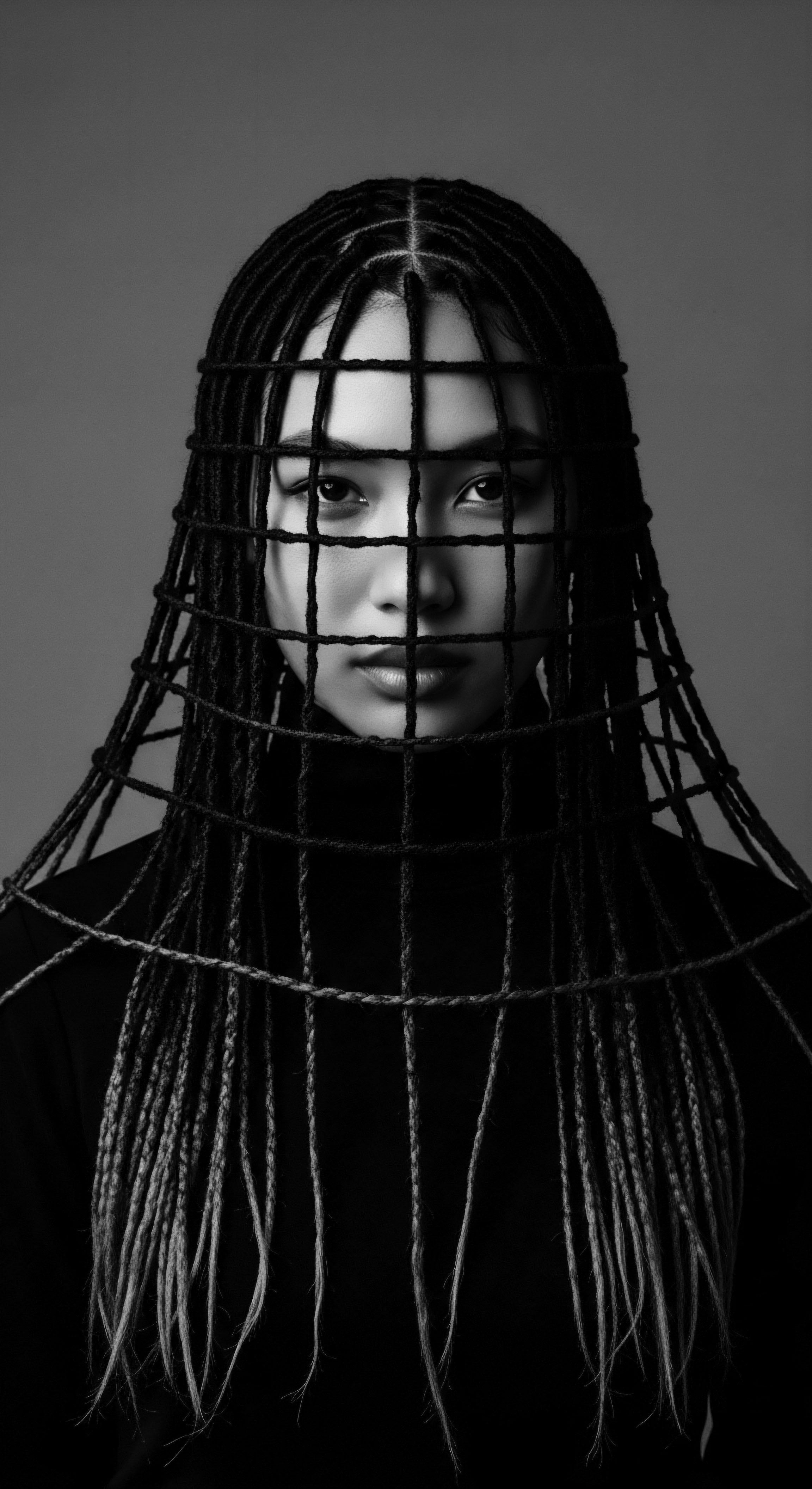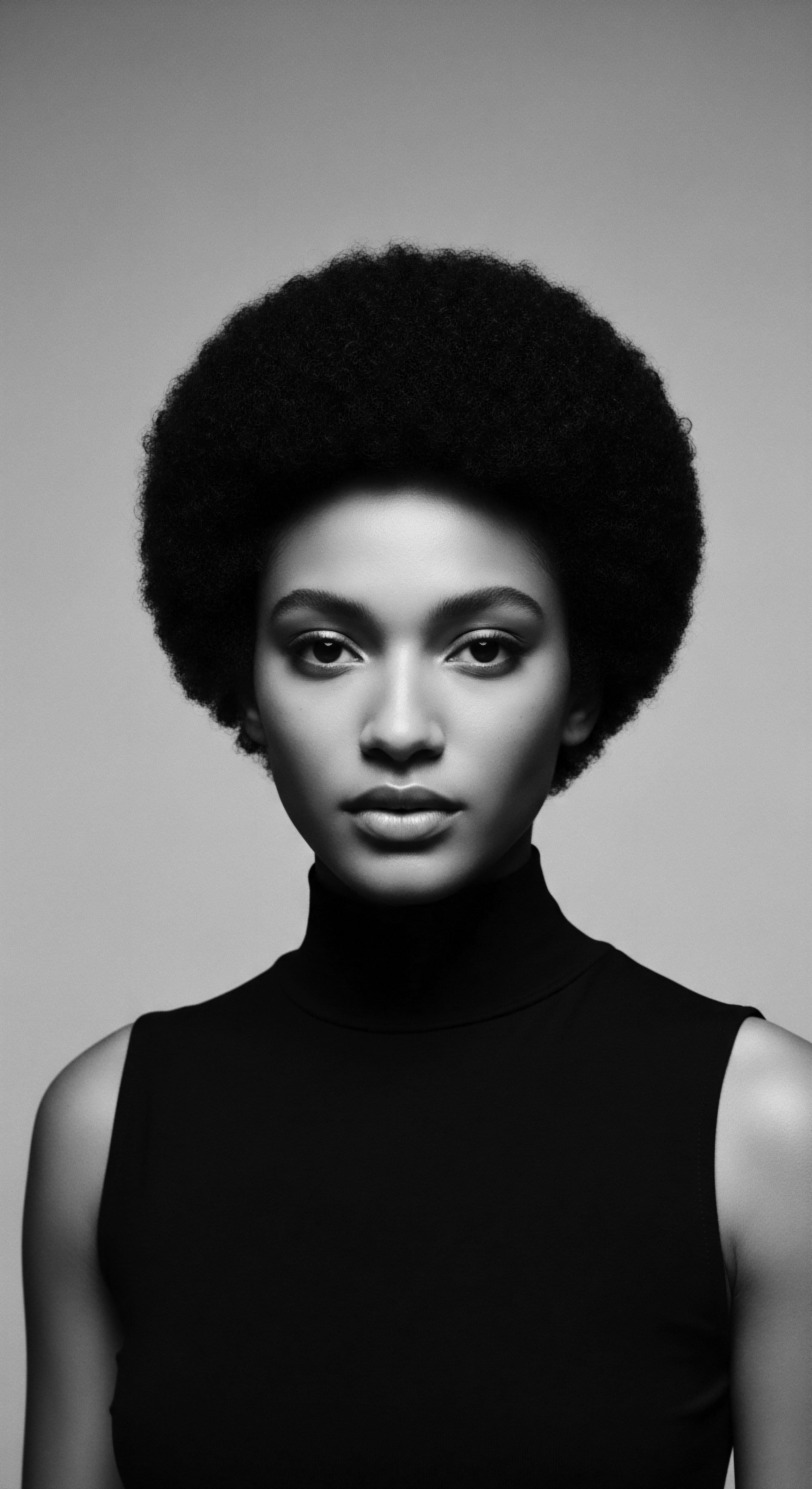
Fundamentals
The very concept of hair dyes, at its most elemental, speaks to a fundamental human desire to express, adorn, and transform. At its core, the Definition of hair dyes centers on substances used to modify the natural color of human hair. This alteration might aim for a lighter hue, a darker shade, or a vibrant, altogether new tone. The fundamental Meaning encompasses not just the chemical or botanical agents themselves, but also the aspiration they embody ❉ a conscious act of shaping one’s outward presentation.
From the earliest whispers of human adornment, altering hair color was never a mere cosmetic whim. It was, and remains, a practice woven into the intricate Tapestry of Identity and cultural belonging. Across continents and through countless generations, communities developed ingenious methods, drawing from the very earth beneath their feet, to achieve desired color shifts. The exploration of hair dyes begins here, rooted in ancestral knowledge and a profound connection to natural elements.

Echoes from the Source ❉ Early Pigments and Practices
Long before the advent of modern chemistry, ancestral communities understood the potency of nature’s palette. Plants, minerals, and other organic materials provided the earliest forms of hair colorants, often imbued with spiritual and social significance. These original practices, far removed from the contemporary salon experience, were deeply integrated into daily life, ritual, and communal identity.
For instance, the application of various plant extracts offered a spectrum of earthy tones. Henna, derived from the dried leaves of the Lawsonia inermis plant, stands as a prominent example, its use tracing back over five millennia to ancient Egypt and spreading throughout North Africa, West Africa, and parts of the Arabian Peninsula. This natural dye imparts a rich red-brown shade, often valued for its ability to cover grey hair beautifully. Its cosmetic applications in Africa extend beyond mere color, as henna also served to strengthen hair strands, adding a natural sheen and bulk.
Similarly, Indigo, sourced from plants of the Indigofera genus, yielded deep blues, and was often used in combination with henna to achieve darker, sometimes black, tones. West African women, for generations, have employed indigo not only for textiles but also as a hair dye, alongside its use in body art and for medicinal purposes.
Ancestral traditions reveal hair dyeing as a profound act of self-expression, often tied to social status and spiritual beliefs.
Beyond these well-known botanical agents, diverse communities utilized other natural components. The Hamar women of Ethiopia and Himba women of Namibia, for example, create a distinctive red hue for their hair by coating it in a mixture of butterfat and red ochre. In West and West Central Africa, hair was integrated into the fabric of culture, with practices and styles revealing a person’s age, birthplace, clan membership, socioeconomic status, marital status, and occupation. Changing hair color, therefore, held a deeper Connotation within these societies, acting as a visual language of belonging and transformation.
- Henna (Lawsonia Inermis) ❉ Utilized across North and West Africa for thousands of years, producing reddish-brown hues and conditioning hair.
- Indigo (Indigofera Spp.) ❉ Combined with henna, particularly in West African traditions, to create deeper blues and blacks.
- Ochre ❉ Mixed with butterfat by communities like the Himba and Hamar, yielding vibrant red tones for hair and skin.

Intermediate
Moving beyond the purely elemental, the intermediate Description of hair dyes expands to encompass a broader historical sweep, particularly the profound shifts brought about by the industrial age and the subsequent development of synthetic compounds. This era introduced new possibilities for hair alteration, but it also brought a complex interplay of evolving beauty standards, often challenging existing cultural practices and introducing new considerations for hair health, especially within communities with textured hair.

The Shift Towards Synthetics and Societal Implications
The mid-19th century marked a significant turning point with the accidental discovery of aniline dyes, paving the way for the synthetic hair colorants we recognize today. These new chemical formulations offered a wider spectrum of colors and longer-lasting results, quickly gaining popularity in Western societies. However, their proliferation introduced a paradigm shift in how hair color was approached, moving from the often gentle, nourishing ancestral methods to chemical processes that fundamentally altered the hair’s structure.
For communities of the Black diaspora, the advent of these new chemical treatments, such as relaxers and permanent dyes, arrived within a societal context that often devalued natural textured hair. Eurocentric beauty standards, which historically favored straight hair, created immense pressure for Black individuals to conform. This societal pressure led to widespread adoption of straightening methods and, subsequently, hair coloring, often using products not formulated with the unique properties of textured hair in mind.
| Aspect Composition |
| Ancestral Practices (Pre-19th Century) Derived from natural plants (henna, indigo), minerals (ochre), and other organic substances. |
| Modern Synthetic Dyes (Post-19th Century) Chemically synthesized compounds, often involving ammonia, peroxide, and various aromatic amines. |
| Aspect Mechanism of Action |
| Ancestral Practices (Pre-19th Century) Coats the hair cuticle, depositing color externally; some slight penetration. |
| Modern Synthetic Dyes (Post-19th Century) Penetrates the hair shaft to alter internal melanin, often requiring opening the cuticle. |
| Aspect Cultural Context |
| Ancestral Practices (Pre-19th Century) Integral to identity, ritual, social status, and spiritual expression. |
| Modern Synthetic Dyes (Post-19th Century) Initially driven by Western beauty ideals, often tied to assimilation pressures; later, self-expression. |
| Aspect Durability |
| Ancestral Practices (Pre-19th Century) Semi-permanent to permanent, fading gradually. |
| Modern Synthetic Dyes (Post-19th Century) Temporary, semi-permanent, demi-permanent, or permanent. |
| Aspect The journey from natural pigments to synthetic compounds reflects humanity's continuous quest for self-expression through hair. |

Navigating the Chemical Landscape ❉ Care and Identity
The Clarification of hair dyes in this intermediate context must include understanding the types of chemical formulations. Permanent hair dyes, which represent a significant segment of the market, use a two-part system ❉ an oxidative dye intermediate (often PPD or a similar compound) and an oxidizer (usually hydrogen peroxide). This process lifts the hair’s cuticle and allows the new color molecules to form within the hair shaft, resulting in a lasting color change. While this offers versatility, it also presents distinct challenges for textured hair, which tends to be more porous and susceptible to damage from chemical processes.
For Black women, who historically faced immense pressure to alter their hair textures to conform to Eurocentric standards, the use of hair dyes became intertwined with complex decisions about identity and societal acceptance. The social and economic realities meant that many sought ways to straighten or “tame” their natural hair, and coloring often accompanied these processes, adding another layer of chemical exposure. This dynamic highlights a crucial point ❉ hair coloring, for textured hair, has frequently been a negotiation between personal desire for expression and external societal expectations.
Hair dyeing in communities with textured hair embodies a complex negotiation between personal expression and societal pressures.
Semi-permanent and demi-permanent dyes, on the other hand, do not use ammonia and generally deposit color on the hair’s surface or slightly penetrate the cuticle, fading over several washes. These options can provide a gentler approach for textured hair, offering a temporary shift in hue without the commitment or potential damage associated with permanent color. Understanding these distinctions is vital for anyone considering hair color, particularly those with delicate natural curls or coils. The very act of choosing a dye type holds a personal resonance within the wider historical narrative of hair care.

Academic
The academic Definition of hair dyes transcends simple categorization, delving into their intricate chemical mechanisms, the socio-historical landscapes of their application, and the profound implications they hold for public health and identity within specific communities, especially those of Black and mixed-race heritage. This scholarly Elucidation requires a rigorous examination of the scientific principles governing color change, juxtaposed with an anthropological inquiry into the cultural forces that have shaped its use across generations. It compels us to consider the molecular interactions alongside the human experiences that imbue these substances with deep collective and individual Significance.

The Chemistry of Transformation ❉ A Deeper Look
At a scientific level, hair dyes are complex formulations engineered to alter the natural melanin within the hair shaft or to deposit new pigment molecules onto its surface. Permanent oxidative hair dyes, the most prevalent type, rely on a sophisticated chemical reaction. These systems typically contain a primary intermediate, often a para-phenylenediamine (PPD) derivative, and a coupler, usually a resorcinol or aminophenol derivative. In the presence of an oxidizing agent, most commonly hydrogen peroxide, these precursor molecules undergo oxidative polymerization within the hair cortex.
This reaction forms larger, colored molecules that are too substantial to exit the hair shaft, thus resulting in permanent color. The process necessitates an alkaline agent, such as ammonia, to swell the hair cuticle, permitting the entry of the dye precursors and oxidant.
The structure of textured hair, with its unique elliptical shape, tighter curl patterns, and often elevated porosity, reacts distinctively to these chemical processes. The raised cuticle scales, characteristic of highly coiled hair, can allow for more rapid absorption of chemical agents but also lead to increased susceptibility to moisture loss and damage during the dyeing process. This physiological reality often translates to heightened vulnerability when harsh chemicals are applied, underscoring the necessity for a nuanced understanding of product chemistry in relation to diverse hair types.
Conversely, semi-permanent and demi-permanent dyes function without ammonia and with lower concentrations of peroxide or none at all. They deposit pre-formed, smaller dye molecules either on the hair’s surface or just beneath the cuticle, which gradually wash out over time. This offers a less invasive alternative, preserving the hair’s structural integrity more effectively, though the color longevity is reduced. The Delineation of these different mechanisms is crucial, as each carries its own set of biological implications for the hair fiber, particularly for sensitive or already compromised textured strands.

Cultural Imperatives and Health Disparities ❉ A Sobering Reality
Beyond the molecular mechanics, the academic pursuit of hair dyes must confront their historical and sociological impact, especially on Black women. During the 20th century, as Western beauty standards permeated global consciousness, there was immense pressure for Black women to straighten their hair to assimilate into dominant professional and social spheres. This often involved chemical relaxers, a practice that, along with the subsequent use of permanent dyes, has been linked to concerning health outcomes.
A particularly compelling, though sobering, example arises from recent epidemiological studies. Research published in the International Journal of Cancer in 2019, which included data from nearly 47,000 women in the Sister Study, highlighted a significant disparity ❉ African American Women Who Regularly Used Permanent Hair Dyes Every Five to Eight Weeks or More Experienced a 60% Increased Risk of Breast Cancer Compared with Those Who Did Not Use Such Products, Whereas White Women Showed Only an 8% Increased Risk. (Eberle, Sandler, Taylor, & White, 2019). This distinct finding underscores the complex interplay of product formulation, frequency of use, and biological susceptibility that warrants deeper investigation. While the exact compounds responsible and the precise mechanisms remain under active study, researchers speculate that the higher concentration of certain chemicals, such as aromatic amines, in products historically marketed to Black women may play a role.
This revelation provides a profound Interpretation of hair dyes, moving beyond aesthetic choice to a public health concern deeply rooted in systemic inequalities. The historical context explains that beauty products marketed to Black women sometimes contain different, potentially more hazardous, chemicals. The pervasive societal expectation that Black women alter their hair to conform to Eurocentric ideals further amplifies their exposure to these substances, creating a disproportionate health burden. This intricate historical and chemical narrative points to the multifaceted Substance of hair dyes in a deeply human context.
The sociological implications extend to the very notion of “good hair” versus “bad hair,” a construct born from colonial and post-slavery eras that privileged textures perceived as closer to European standards. Hair dyeing, in this context, becomes a complex expression of identity, self-acceptance, and, at times, a quiet rebellion against imposed norms. The shift towards the natural hair movement in recent decades, encouraging the celebration of diverse textures, represents a powerful counter-narrative, yet the historical legacy of chemical alteration continues to inform health considerations for many within the community.
The scientific scrutiny of hair dyes, especially for textured hair, reveals a historical burden of health disparities rooted in societal pressures.
The academic investigation also calls for a critical examination of regulatory frameworks surrounding cosmetic products. The fact that many potentially harmful chemicals remain unregulated in the U.S. particularly within products disproportionately used by Black women, signals a systemic oversight.
This leads to a deeper comprehension of the health implications and the urgent need for more transparent ingredient labeling and targeted research that addresses the specific needs of diverse hair types and their historical care practices. The very Explication of hair dyes, therefore, becomes a call for advocacy and informed choice, grounded in both scientific rigor and ancestral wisdom.
- Oxidative Dye Ingredients ❉ PPDs and related compounds, often paired with hydrogen peroxide, induce permanent color by forming large molecules within the hair.
- Alkalizing Agents ❉ Ammonia or alternatives swell the cuticle, enabling dye penetration into the cortex, a critical step for permanent color change.
- Societal Pressure & Exposure ❉ Historically, the drive for conformity to Eurocentric beauty standards led Black women to frequent use of chemical relaxers and permanent dyes, increasing exposure to potentially harmful compounds.
The academic lens also permits a deeper Clarification of the role of hair color in cultural identity. In many African societies, hair styling and adornment were not merely aesthetic but acted as profound indicators of social standing, age, marital status, and even spiritual connections. When enslaved Africans were forcibly stripped of their hair practices, it was a deliberate act of dehumanization, a severing of a vital link to their heritage and identity. The resilience of these traditions, however, persisted, adapting and re-emerging in various forms across the diaspora.
Even the choice of a specific color, whether natural or chemically achieved, became a declaration of self, a reclaiming of agency in a world that sought to deny it. This profound Meaning extends into contemporary practices, where hair color can be a statement of artistic expression, a connection to ancestral aesthetics, or a subtle defiance of beauty norms.

Reflection on the Heritage of Hair Dyes
In contemplating the journey of hair dyes, from ancient earth-derived pigments to the intricate chemical formulations of the present, a compelling narrative unfolds—one that is deeply intertwined with the Heritage of textured hair. Our exploration reveals that altering hair color has never been a superficial act; it is a resonant echo from ancestral practices, a living testament to human adaptability, and an enduring canvas for self-expression. The very concept of hair dyes, viewed through the lens of Black and mixed-race hair experiences, stands as a profound meditation on identity, resilience, and the continuous quest for beauty.
From the ancient African societies where henna and indigo adorned hair for spiritual ceremonies and social indicators, to the diasporic communities that navigated the complexities of chemical straighteners and dyes in the face of imposed beauty ideals, the story of hair dyes is a human story. It speaks to the ingenuity of our forebears, who understood the earth’s abundant gifts, and the enduring spirit of those who, despite historical adversities, continue to reclaim their hair’s inherent beauty and significance. The whispers of traditional knowledge, passed down through generations, often find unexpected resonance with modern scientific understanding, reminding us that wisdom spans across time.
The choice of hair color today, whether a return to ancestral shades or a bold new hue, extends beyond aesthetics. It is a dialogue with history, a conscious act of connection to a rich legacy, and a personal declaration of autonomy. This is the enduring Essence of hair dyes within the realm of textured hair ❉ a dynamic interplay between elemental biology, cultural legacy, and the boundless potential of self-discovery, all rooted in the soulful wisdom of the strand.

References
- Alassadi, F. (2023). Feminism, Medicine and Culture ❉ How chemical/medicinal.
- Byrd, A. D. & Tharps, L. L. (2014). Hair Story ❉ Untangling the Roots of Black Hair in America. St. Martin’s Press.
- Eberle, C. E. Sandler, D. P. Taylor, K. W. & White, A. J. (2019). Hair dye and chemical straightener use and breast cancer risk in a large U.S. population of black and white women. International Journal of Cancer, 146(5), 1237-1246.
- Fagbohoun, B. & Vieillescazes, C. (2020). Indigo from Indigofera spp. ❉ Historical and Cultural Overview. UF/IFAS EDIS.
- Mbilishaka, A. M. (2024). Don’t Get It Twisted ❉ Untangling the Psychology of Hair Discrimination Within Black Communities. American Journal of Orthopsychiatry.
- Schœlcher, V. (1842/1998). Esclavage et colonisation. Presses Universitaires de France.
- Sri Bhuvaneswar, A. et al. (2021). Indigo and Henna ❉ Natural Brilliance for Healthy, Vibrant Hair Colour. Heritage Essentials.
- White, A. J. et al. (2019). Hair Dyes And Straighteners Linked To Higher Cancer Risk, Especially For Black Women. NPR Health News.
